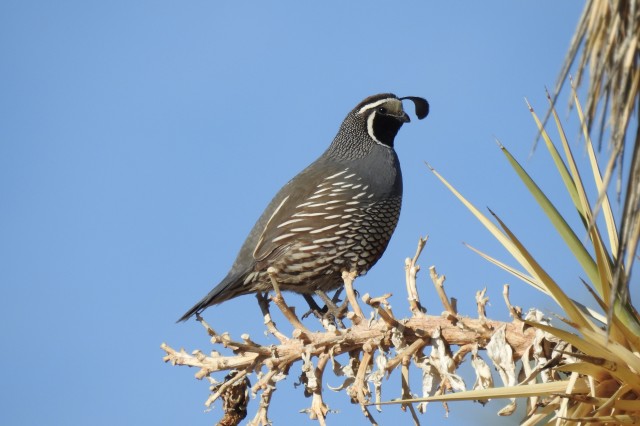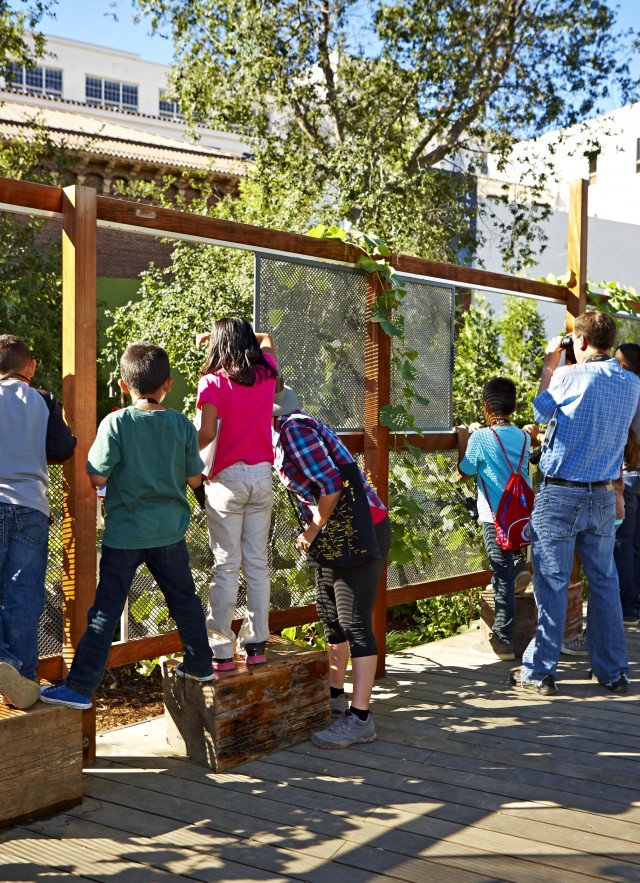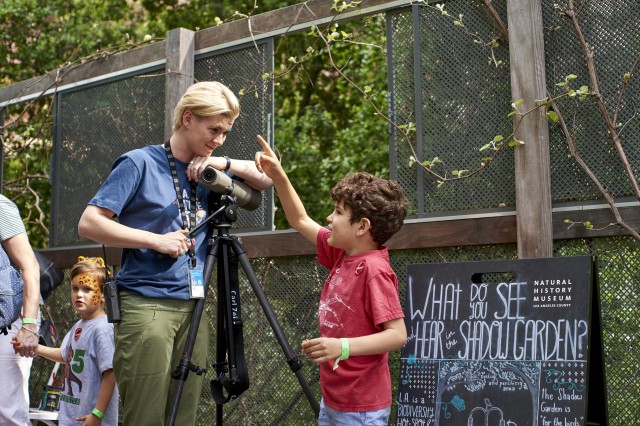
Sounds of Nature

Overview
Duration
Pre-Visit: 20-30 minutes | Museum/Site Visit: 15-20 minutes | Post-Visit: 60 minutes
Concepts
- Listening is an important method for observing nature and recording observations
- Note-taking and clear descriptions are necessary for species identification
- The number of species identified in any ecosystem is a good indicator of its overall health (generally, the more diverse, the healthier the ecosystem)
Learning Objectives
- Students will practice listening skills by observing birdcalls
- Students will craft written descriptions of their observations and use them to
- Students will experience the biodiversity and nature of urban L.A.
Outline
- Students will practice describing sounds using bat and bird calls indoors, with the help of a sound word list. Each student will describe 4 bat calls and 4 bird calls, and then choose one of their descriptions for a partner to identify.
- Outside—either in the Nature Gardens at NHM, at your school site, or in a nearby outdoor environment—students will use their new skills to describe real-time birdcalls.
- Using online resources and/or recordings, students will be able to use their descriptions and observations to identify bird species
- As a class, students will graph their data, recording both the variety of species and the number of individuals per species.
Activity
Pre-Visit
Bat Calls
Ask students to listen to the four bat calls in this article.
After listening to each sound, give students 2-3 minutes to write a description of the sound they heard, using the words in the Sound Word Vocab List (at the bottom of the page) as inspiration. There are many more words they could use, but these will help get them started. Reassure students that there is no correct word to choose—this is all about just writing down what they hear.
There may be different parts to the sound that require different words. For example, this seagull call might be described as, “Two ascending (going up) short squawks, then longer high shrieks, descending (going down) to squawks again.”
BIRD CALLS
Next, play the calls of these common L.A. birds (Scroll down and look for the audio play button under the silhouette of the bird). Give students 2-3 minutes to write a description of each call after you play it:
Description Swap
When they’re done with their descriptions, have students partner up. Ask them to pick one of their descriptions and give it to their partner. Explain that their job is to figure out which bird call their partner was describing. Play the bird calls again. Depending on how successful the class is at matching the calls with the description, allow students some time to recommend revisions for their partner’s description. What kind of information could they add to make the description clearer or more accurate? What made it hard for the student to guess?
Museum / Site Visit
If you are doing this activity on a Museum visit, head out to the Nature Gardens with notebooks and pencils, and visit the Bird Viewing Platform or the hummingbird feeders in the 1913 Garden. This can also easily be done on any school site or nearby outdoor environment! Remind students that holding still and staying as quiet as possible will help prevent scaring birds and animals away.
Ask students to listen for and write a description of 3 bird sounds in the next 15 minutes. It may take some trial and error to develop a good method—for example, some students might like to listen carefully and take notes after the noise has ended, while others might need to take quick notes while they’re listening, which they later turn into a description.
If students can get a visual on the bird, ask them to also jot down notes about color, size, location, and any identifying features of the bird.
Post-Visit
Using eBird's List of Sightings in Los Angeles and/or Cornell Lab of Ornithology’s website (www.allaboutbirds.org), ask students to use the descriptions and notes they created outdoors to identify the bird. Start with the eBird List to get some names of common Los Angeles area birds that you might have seen—if you’re in downtown L.A., for example, most likely you didn’t observe any sandpipers or pelicans. Then, look up the possible candidates on the Cornell Lab of Ornithology website and listen to the calls to try to match. Use any visual details about the birds such as size, color, and overall morphology to help.
If students have trouble positively IDing their birds, ask them to list the top two or three birds they think it could be.
Once students have identified their birds, create a class graph or data table that shows how many different species of birds and how many of each species were observed.
Variations & Extensions
If students have access to smartphones or iPads, considering asking them to download the SoundCloud app. Using this app, have students record bird calls during the Museum visit and then write their descriptions from the recordings.
Submit the SoundCloud recordings by either uploading them to the Natural History Museum’s iNaturalist project, “L.A. Nature Map,” or e-mailing them to nature@nhm.org. Click here for instructions on how to create an iNaturalist account.
Additional Resources
SOUND WORD VOCAB LIST
Song/Call
Bark, Peep, Twitter, Cheep, Chirp, Ping
Hoot, Screech, Squeak, Squawk, Shriek
Cluck, Click, Clack, Swish
Grating/Grinding
Whirr, Wheeze, Growl
Cackle, Ripple, Trill, Clatter, Rat-a-tat
Short or Long
High or Low
Descending (going down) or Ascending (going up)
Long pause, Close-together, Pulse
Standards Alignment
NGSS
LS1.D, LS4.D
S+E Practices 3, 4
CCSS ELA
K-12 W.7, W.8
